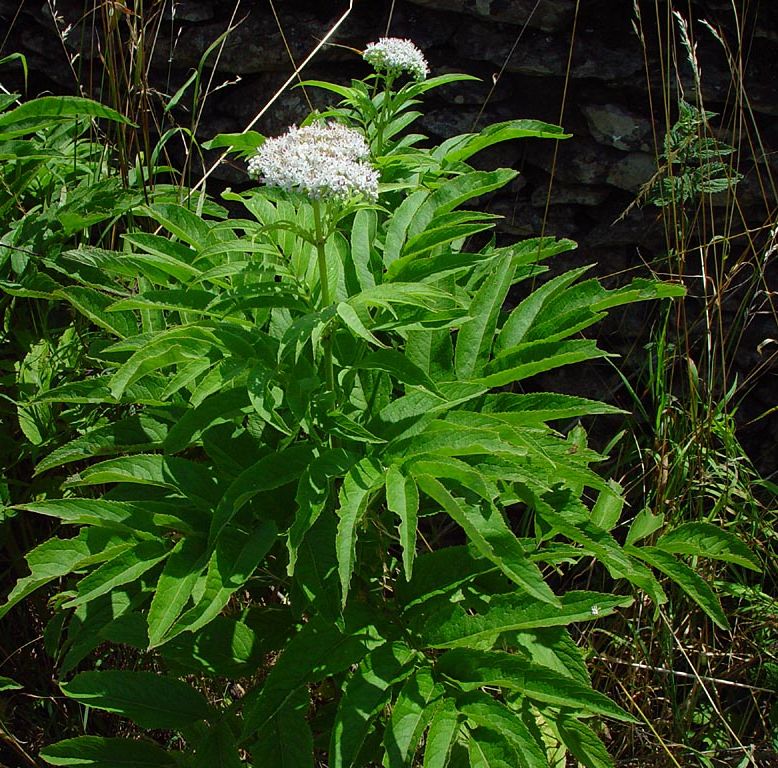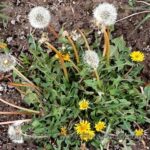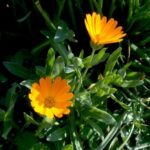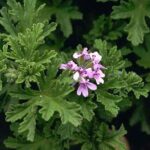Effects: Laxative, anti-rheumetism. Alkaloid plant (sambuca), essential oil, glycoside, anthocyanen, flavonoid, saponin.
Use: While the black fruit is toxic and so dangerous for human consumption, the root has more beneficial laxative-purgative properties and is further used for its diuretic as well as anti-rheumatism benefits.
Background information: The name Sambucus may have derived by a musical instrument, a flute known as a "sambuca". The airy parts of the plant contain a gastro-toxic principle which remains as yet poorly identified. The definition of Elder is any of a genus (Sambucus) of shrubs and small trees of the honeysuckle family, with compound leaves and flat-topped clusters of small white flowers followed by red or purple berries
[wpspoiler name=”Where to find it”]Ireland: Forming dense stands in hedgerows, on rough ground and woodland margins, Dwarf Elder is a large perennial which grows to a height of 1.5m
Germany: It grows at the edges of forests, at glades and along country roads.
Greece: It is found in ditches, along roadsides, near abandoned houses, fences, in wet valleys and streams banks.
Poland: In Poland it is quite common in the south
Italy: Found alongside hedges, country roads and in uncultivated areas over the May to July period. It grows to a height of 1,3 metres[/wpspoiler]
[wpspoiler name=” Cultural aspects(stories/songs)”]Ireland: The Irish name for Dwarf Elder is Tromán. A close relation, Sambucus canadensis is known as The Elder Mother; The Queen of Herbs. Associated with the 13th month of Celtic Tree calendar, November 25 – December 21 & 13th consonant of the Ogham alphabet – Ruis. The elder is associated with beginnings and endings, of birth and death, so the elder fairy is a spirit of transformation and the crossing of thresholds. Generally seen as an old woman, the elder fairy advises on what to cast away and what to take up.
Germany: Named Zwergholunder or Attich in German. In the Middle Ages dwarf elder was planted around castles as protection against different horse diseases.
According to an English legend it grew out of the blood of the Danes who died in the battle between Edmund Ironside and Canute the Great in the 11th Century. The plant is in England also called Danesblood or Danewort.
Greece: N/A
Poland: N/A
Italy: The plant was believed to keep mice and moles at bay.[/wpspoiler]
[wpspoiler name=”Contemporary use(cuisine/ cosmetics/medicine)”]Ireland: The small, edible, purplish-black fruit of this plant are used in cooking and to flavour drinks.
Germany: The plant is diuretic and diaphoretic but difficult to dose and the leaves are toxic, so that today it is rarely used.
Greece: The infusion of the flowers with honey was used as soothing the nervous system, slight narcotic, stimulant expectorant respiration and minor.
Poland: Puree of raw fruits hebdu has a strong antifungal, but only externally with onychomycosis. To achieve the effect should be applied for several days.
Italy: The fruit produces a blue colourant, while the juice of the root is used as a hair dye. The fruit may be consumed only after being cooked.[/wpspoiler]
[wpspoiler name=”Traditional use (remedies, uses)”]Ireland: Traditionally all parts of Elder are useful medicinally. The berries and the leaves of the Sambucus canadensis are both rich in vitamin C. The leaves can be made into ear drops to treat pain and inflammation. The flowers make a tea that is good for treating coughs and irritable throats, as well as being made into a skin cleanser and lotion. The bark of the new small twigs can be made into a laxative. The bark, roots, berries and leaves can all be used as a dye. And the berries are good for making jam, wine, vinegar, and syrups. One well-known remedy, which uses black elderberry as a main ingredient, is the cough remedy Sambucol.
Germany: N/A
Greece: The root of Sambucus ebulus is diuretic and slightly laxative. Berries are toxic and should not be confused with the fruits of Sambucus nigra. In folk medicine, however, is still used as a diuretic, sudorific and emollient bowel. The pulverized root, bark and seeds are still used as laxatives. The flowers are painless and sudorific in small doses. Leaves have the same properties as the flowers and used mainly in solvents and anti-inflammatory poultices.
Poland: Harvesting and drying: root dug in autumn or early spring, cut into thinner pieces and dried in the dryer
Italy: The plants antioxidet agents assist in reducing the cholesterol level of the blood.[/wpspoiler]





